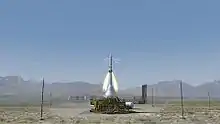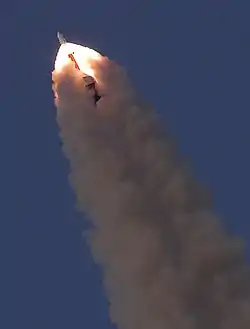Pad abort test
A pad abort test is a test of a launch escape system to determine how well the system could get the crew of a spacecraft to safety in an emergency on the launch pad.
Project Mercury

The Mercury program included several pad abort tests for the launch escape system with a boilerplate crew module.
- 1959 July 22 – First successful pad abort flight test with a functional escape tower attached to a Mercury boilerplate
- 1959 July 28 – A Mercury boilerplate with instruments to measure sound pressure levels and vibrations from the Little Joe test rocket and Grand Central abort rocket/escape tower
Project Apollo

The Apollo program included several pad abort tests for the launch escape system with a boilerplate crew module.
- Pad Abort Test-1 was conducted on November 7, 1963, and
- Pad Abort Test-2 was conducted on June 29, 1965.
Both tests were conducted at the White Sands Missile Range.
Orion

The Orion pad abort test was started with the construction of the first Orion boilerplate. It is a basic mockup prototype to test the assembling sequences and launch procedures at NASA's Langley Research Center. Lockheed Martin Corp. was awarded the contract to build Orion on August 31, 2006. The first pad abort test trial of the escape tower system was successfully completed at New Mexico's White Sands Missile Range on May 6, 2010.[3][4]
Commercial Crew
.jpg.webp)

Dragon 2
SpaceX Dragon V2 Pad Abort Test-1 was conducted on May 6, 2015 at approximately 0900 Eastern Daylight Time (EDT). (A video clip released by SpaceX shows the timestamp of the moment of launch as 13:00:00). The vehicle splashed down safely in the ocean to the east of the launchpad 99 seconds later.[5] A fuel mixture ratio issue was detected after the flight in one of the eight SuperDraco engines, but did not materially affect the flight.[6] More detailed test results were to be subsequently analyzed by both SpaceX and NASA engineers.[7]
Starliner
The pad abort test of Boeing's Starliner craft was conducted at 14:15 UTC on November 4, 2019 at the White Sands Missile Range.[8] The capsule was lifted to 1,350 m (4,430 ft) and landed with airbags approximately 90 seconds after liftoff. Though the test was deemed a success, one of three main parachutes failed to deploy properly.[9][10]
ISRO pad abort test

On 5 July 2018, Indian Space Research Organisation successfully conducted a pad abort test at Satish Dhawan Space Centre, Sriharikota. A first in a series of tests to qualify a crew escape system.[11]
After a smooth countdown of five hours, the crew escape system, along with the simulated crew module with a mass of 12.6 tonnes, lifted off at 07.00 AM (IST) at the opening of the launch window from its pad at Satish Dhawan Space Centre, Sriharikota. The test was over in 259 seconds, during which the crew escape system along with crew module soared skyward, then arced over the Bay of Bengal and floated back to Earth under its parachutes about 2.9 km from Sriharikota.
See also
- Soyuz T-10-1, a Soyuz mission which ended with the use of the launch escape system
References
- Mercury Pad Abort Tests
- NASA History Archives
- http://vimeo.com/11631855
- NASA's Project Constellation Official Site
- Clark, Stephen (6 May 2015). "SpaceX crew capsule completes dramatic abort test". Spaceflight Now. Retrieved 14 May 2015.
- "SpaceX Crew Dragon pad abort: Test flight demos launch escape system". CollectSpace. 6 May 2015. Retrieved 14 May 2015.
- Bergin, Chris (6 May 2015). "Dragon 2 conducts Pad Abort leap in key SpaceX test". NASASpaceFlight.com. Retrieved 6 May 2015.
- "Boeing/Starliner in successful Pad Abort Test; some issues observed". NASASpaceFlight.com. 2019-11-04. Retrieved 2020-06-23.
- "Boeing performs Starliner pad abort test". SpaceNews.com. 2019-11-04. Retrieved 2020-06-24.
- Clark, Stephen. "Boeing tests crew capsule escape system – Spaceflight Now". Retrieved 2020-06-24.
- "Suiccessful Flight Testing of Crew Escape System – Technology Demonstrator – ISRO". www.isro.gov.in. Retrieved 2018-07-05.
